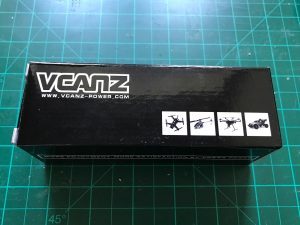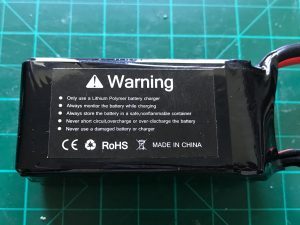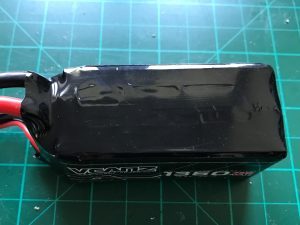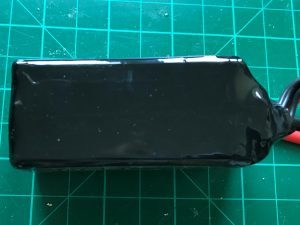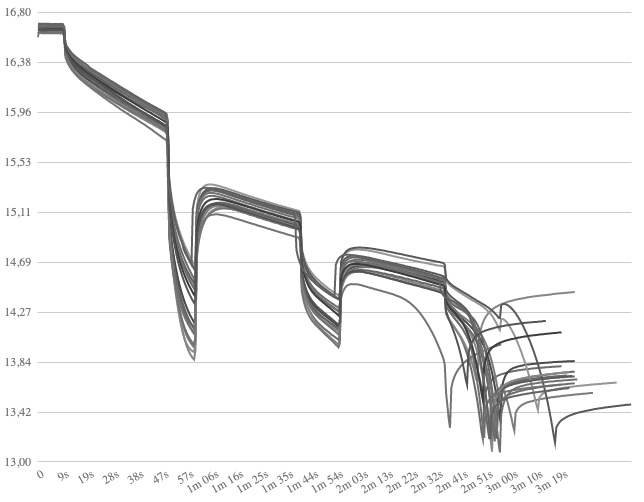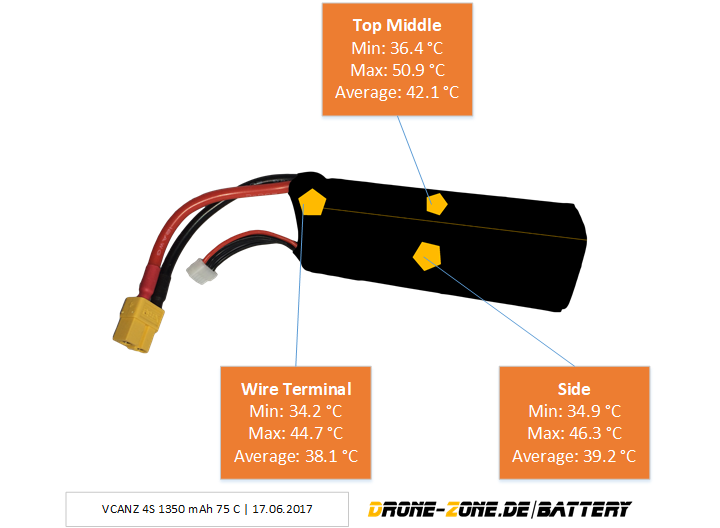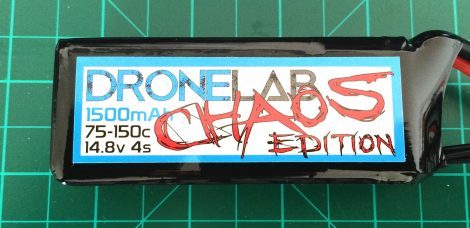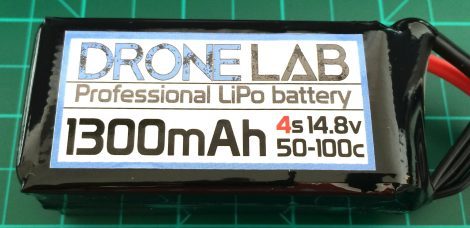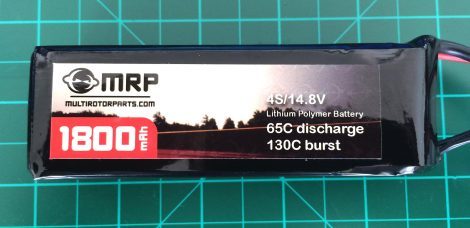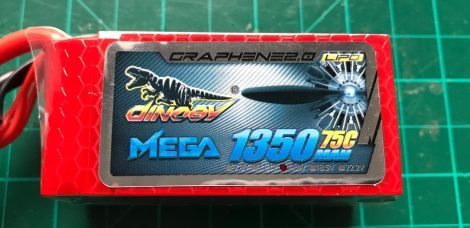Chinese battery manufacturing brand VCANZ Power contacted me to see if I would review their latest FPV flight packs. Of course, I couldn’t resist taking that offer and here we are: my latest review of the VCANZ 4S 1350 mAh battery with a 75 C rating.
Appearance
VCANZ Power is still a relatively unknown high performance RC battery manufacturer. The current 4S FPV flight pack series comes in two performance levels: 75 C and 95 C rated. VCANZ therefore is tackling well established brands in the high performance lipo battery segment. We will see how that goes a little later. First let’s have a look at the outer appearance of the battery. VCANZ decided to use shiny black shrink wrapping on most parts of the pack. The front and back are protected by a white layer of foam. The stickers a mostly colored black as well. On the front sticker you find the usual product features, the back stickers holds standard security advises. It would be nice to see the actual maximum pack values like max. charging rate as well as recommended cut-off voltages to be directly printed onto the battery as well. Otherwise the pack comes nicely packed in a cardboard box, securely packaged in bubble wrap. On top you get a VCANZ sticker and a branded battery mounting valcro strap. Cool!
Technical Design
The VCANZ Power 75 C pack is a standard 4S1P config flight pack for high power use. It utilizes standard non-graphene enabled lithium polymer chemistry.
Build Quality: Very good. Pack feels very well made on the outside. Connection terminal looks solid. The dark / black design makes the pack the perfect companion for almost every mini quad design.
Plugs: The VCANZ pack comes with standard XT60 connectors* equipped – in yellow color.
Cables: VCANZ uses 12 AWG wires on this packs. The high flexible silicon layer is rated up to 200°C. Cable length is about 9 centimeters.
Balacing plugs: Standard XT-system*. Balance wires are short (3 cm) which is a benefit in terms of getting them out of the prop-range on the aircraft. Main power line are connected to the top, balancer wires are coming out at the bottom of the pack.
Technical Details
Break-in documentation
The battery followed the standard break-in-process: The pack is charged at a rate of 1C until CV-phase ends with current of 1/10C. The break-in phase consists of four charging cycles at 1C and four corresponding discharges at 1 C / 4C / 10C and 20 C.
Anomalies: No anomalies during break-in.
Internal resistance measurements during break-in phase
| Cycle | Cell 1 | Cell 2 | Cell 3 | Cell 4 | Total |
| After first charge | 2.0 | 2.0 | 1.5 | 1.8 | 7.3 |
| After second charge | 2.2 | 2.0 | 1.8 | 1.8 | 7.8 |
| After third charge | 1.8 | 2.2 | 1.6 | 2.0 | 7.6 |
| After fourth charge | 1.9 | 2.1 | 1.8 | 1.9 | 7.7 |
Charging process
CV-Phase is short on this cell type. Balancing in normal mode took 1:15 min. Cell drift during charge was unobtrusive. This is for 1C charge (1.4 A).
Load Testing
The main part of this battery test will consists of different load test settings showing the battery performance. Constant load testing is used to judge the advertised C-ratings as well as look at cell drift under high loads. We also check on internal resistance once more. Next up is the dynamic current test, which simulates a „real“ flight with changing (=dynamic) loads. For test methodology please check the dedicated methodology page!
Constant Load Testing
Constant load testing follows a certain load pattern of different constant currents. Base load is 10 C. Current pulses at 50 C, 35 C, 20 C and 30 C are maintained for time intervals between 10 and 20 seconds. For more details please refer to the test methodology page.
Capacity Usage
During this test the pack delivered 977 mAh. This is 72,4 % of nominal capacity. An average result.
Average cell voltages
The following table lists the average voltages per cell, of the total pack, as well as the averaged value per cell as fraction of total voltage during phase of active load.
| Cell 1 | Cell 2 | Cell 3 | Cell 4 | Total | Average per cell | |
| Avg. Voltages | 3.735 V | 3.736 V | 3.742 V | 3.738 V | 14.950 V | 3.738 V |
Just looking at average values the VCANZ pack performs good. All cells stayed well above 3,7 V on average. An average value above 3,74 V / cell can be considered very good. The 75C version misses this mark by only a bit.
Focus Voltages
Exceptionally interesting when testing a battery under a constant load for a longer period of time: the lowest voltage per cell just before load impulse is disabled. On top, you should have look at voltage recovery rate, that is: how fast do cell voltages rise again once load impulse is cut.
| Phase | Cell 1 | Cell 2 | Cell 3 | Cell 4 | Total |
| End of 50 C | 3.464 V | 3.482 V | 3.509 V | 3.542 V | 13.997 V |
| End of 35 C | 3.517 V | 3.525 V | 3.542 V | 3.556 V | 14.140 V |
| End of 20 C | 3.266 V | 3.247 V | 3.293 V | 3.280 V | 13.097 V |
| End of 30 C | – | – | – | – | – |
Voltage sag generally is okay on the VCANZ 1350 mAh 75 C pack. The 3,5 V/cell benchmark was not met on the 50 C discharge cycle, though. Cell 1 and 2 went noticeably below 3.5 V.
Average voltage recovery per second
Those values are specific to the test setting and not valid for the pack in general! Still they allow an estimated guess about how fast voltages rise again after current spikes.
| Cell 1 | Cell 2 | Cell 3 | Cell 4 | Total | |
| Avg. Recovery | 0.0462 V / s | 0.0440 V / s | 0.0351 / s | 0.0351 V / s | 0.1658 V /s |
Voltage recovery is quick for the battery.
IR-Measurement
IR measurement is conducted using the four current pulses. Resistance for each cell is calculated in all four discharge phases. Shown values are averaged to cancel out different temperature points due to different discharge states during measurements.
| Cell | 1 | 2 | 3 | 4 | Total |
| Resistance [mΩ] | 3.32 | 3.27 | 2.83 | 3.03 | 12.45 |
Interpretation: The internal resistance of 3.11 mΩ average per cell indicates a „true“ C-rating of around 38 C (51.0 A). This is on the conservative side and represents a current draw that will make the pack last for a long time. Overall performance can be described as high. The calculated true C-rating matches the observed performance of the battery under high constant loads (50 C) where voltage sag was quiet strong.
Cell drift under load
| Discharge Phase | 50 C | 35 C | 20 C | 30 C |
| Max Cell drift (V) | 0.037 V | 0.039 V | 0.033 V | – |
Cell drift is very low on the VCANZ 75 C version packs during main discharge phase. Cells are matched nicely on our test pack!
Key Temperature Facts
Temperature Development
Max. temp during discharge was around 50.9 °C on top of pack. Note that heating of stressed LiPo packs will continue for some more time even when load is cut.
Market Comparison
The following chart shows all reviewed LiPos in the same product segment for direct comparison of performance. Higher values under load are better.
Constant 25 C Discharge
Pretty much a standard benchmark in the LiPo industry.
Cut-Off /warning value for this battery should be chosen 3.5 V minimum. After this point voltage drops quick. The battery provided 975 mAh (72,0 %) during the 25 C discharge.
Market Overview
Comparison of different reviewed 1300 mAh batteries under 25 C load.
Dynamic Load Testing
The dynamic load testing setting consists of two separate discharge scenarios that have been developed of two different real-life FPV flights. Pattern one represents a high speed low proximity flight around the open field with some hovering to the end. Average load is around 22 A. Second pattern is a free-style flight around trees in the park with some current spikes near 70 A. Average load on this flight is around 13 A due to longer floating periods.
Capacity Usage
During the test of pattern 1 the pack delivered 975 mAh. This is 72.0 % of nominal capacity. Good. In patter 2 testing 962 mAh (71.3 %) could be used until first cell reached cut-off voltage.
Market Comparison
The following charts give an overview of all tested packs in the 1300 mAh class so far.
The last chart of this review sums up the usable capacity during all four load scenarios. Please note that this is only the capacity consumed by the electronic load! There are losses due to heating of the pack, which could be approximated (see testing methodology page). All four tests are cut when any cell goes below cut-off voltage of 3,3 V (or pack goes above 58 °C on any of the three probes). If you would push further and go down to 3,0 V/cell you will be able to squeeze out some mAh more, but at the cost of excessive heat generation and shortening of pack life-span. This value will most likely differ from what you get when flying on a quad as most people don’t monitor voltage on a per cell basis and therefore don’t even notice if voltage drops below 3,3 V/cell during punsh-outs (what’s not necessarily a good thing, though). For comparison, used capacity until 3,3 V/cell is reached is the base line in all battery reviews on Drone-Zone.de.
Conclusion
The VCANZ 4S 1350 mAh 75 C battery is a compact sized pack with a capacity to weight ratio of 9.06 mAh/g. It therefore is a few grams lighter than the competition. Build quality of this battery is very good, as is the packaging the pack comes in. The pack is rectangular shaped and keeps it shape under every load situation. No puffing at all. Most heat is dissipated through top and bottom. The mostly black design should optically fit almost any quad build. Voltage stability is okay on theVCANZ 4S 1350 mAh 75 C pack. High load impulses to the end of the discharge cycle bring down the cell voltages quiet a bit, though. Cut-off should be chosen at 3,5 V / cell minimum. Usable battery capacity is average and on par with most competitors. Cell matching on our test sample is very good. The rating of 75 C still is a bit over the top, of course. I would rate this pack at very good 38 C continuous. This allows you to pull around 51.0 A continuous without having to worry about the packs health too much. More than enough power for most of the applications out there! As you can see in the dynamic loads higher current spikes are overall handled well, but not as well as on the 95 C version of the product. The retail price of US-$ 30 is average, I think you might be able to pick one up a little cheaper if you look online. Overall the VCANZ 75 C version is a good option for pilots looking for a well manufactured and light pack, but are not in the market for highest ampacity (=C rating) available.
Other batteries in this capacity class:



